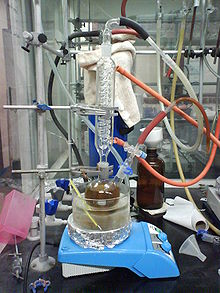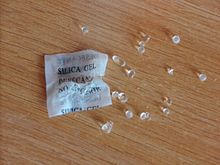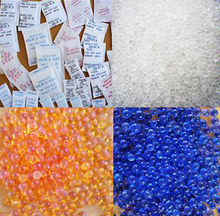- Desiccant
-
A desiccant is a hygroscopic substance that induces or sustains a state of dryness (desiccation) in its local vicinity in a moderately well-sealed container.
Commonly encountered pre-packaged desiccants are solids, and work through absorption or adsorption of water, or a combination of the two. Desiccants for specialized purposes may be in forms other than solid, and may work through other principles, such as chemical bonding of water molecules.
Pre-packaged desiccant is most commonly used to remove excessive humidity that would normally degrade or even destroy products sensitive to moisture. Some commonly used desiccants are: silica gel, activated charcoal, calcium sulfate, calcium chloride, montmorillonite clay, and molecular sieves. Silica gel is often used in musical instrument cases.
Rice is a common "low-tech" alternative frequently used, for example, in salt-shakers to maintain granularity of table salt for effective pouring or shaking. Rice, however, is not a good general purpose desiccant since, unless immersed in an organism-hostile environment like pure salt, over time may be eaten by creatures that might in turn contaminate the product that is being preserved. Salt itself is another effective desiccant, used for millennia in preparation of dried food and also to mummify corpses.
A specific usage of a desiccant would be in insulated windows where it is placed inside the spacer between the air space and window edge. This prevents moisture condensation between the panes.
Contents
Toxicity
A desiccant may be chosen for a particular task based not only on its effectiveness at drying, but also perhaps for any natural antibiotic, fungicidal, pesticidal, or virucidal effect, or for a lack of harmful effect on humans. For instance, table salt has a natural antibiotic and anti-fungal effect and is not harmful to humans when consumed in moderate quantities, and is thus commonly used as a drying agent in the preparation of dried foods.
Chemical reactivity
Because of their common use in preservation, it is usually desirable for a desiccant to be substantially chemically stable or chemically inert, and a number of useful desiccants with this property have been identified and are in common use, such as silica gel, chalk and clay-based desiccants.
Performance efficiency
One measure of desiccant efficiency is the ratio (or percentage) of water storable in the desiccant, relative to the mass of desiccant.
Another measure is the residual relative humidity of the air or other fluid being dried.
The performance of any desiccant varies with temperature and both relative humidity and absolute humidity. To some extent, desiccant performance can be precisely described, but most commonly, the final choice of which desiccant best suits a given situation, how much of it to use, and in what form, is made based on testing and practical experience.
Coloured saturation indicators
Often some sort of humidity indicator is included in the desiccant to show, by color changes, the degree of water-saturation of the desiccant. One commonly used indicator is cobalt chloride (CoCl2). Anhydrous cobalt chloride is blue. When it bonds with two water molecules, (CoCl2•2H2O), it turns purple. Further hydration results in the pink hexaaquacobalt(II) chloride complex [Co(H2O)6]Cl2.
Drying of solvents
 Toluene is refluxed with sodium and benzophenone to produce dry, oxygen-free toluene. The toluene is dry and oxygen free when the intense blue coloration from the benzophenone ketyl radical is observed.
Toluene is refluxed with sodium and benzophenone to produce dry, oxygen-free toluene. The toluene is dry and oxygen free when the intense blue coloration from the benzophenone ketyl radical is observed. See also: air-free technique
See also: air-free techniqueDesiccants are also used to dry solvents, typically used for moisture free reactions (e.g. the Grignard reaction). While various desiccants are used in a variety of ways, the method generally involves stirring the desired solvent with the drying agent.
Often, the drying agent will react with moisture to form an insoluble solid in the solvent being dehydrated, thus the precipitate can be removed by filtration. For more demanding applications, requiring very pure, anhydrous solvents a distillation still is used to remove moisture and other impurities simultaneously.
See also
- List of desiccants
- Humidity buffering
- Humidity indicator card
- Hygroscopy
- Solar air conditioning
- Sorbent
- Zeolites
References
Further reading
- Chai, Christina Li Lin; Armarego, W. L. F. (2003). Purification of laboratory chemicals. Oxford: Butterworth-Heinemann. ISBN 0-7506-7571-3.
- Lavan, Z.; Jean-Baptiste Monnier, Worek, W. M. (1982). "Second Law Analysis of Desiccant Cooling Systems". Journal of Solar Energy Engineering 104 (3): 229–236. doi:10.1115/1.3266307.
- S. Sadik; J. W. White (1982). "True potato seed drying over rice". Potato Research 25 (3): 269. doi:10.1007/BF02357312.
External links
- Desiccant Science and Tehnology Published Paper
- Desiccant Requirement Chart (printable)
- Latest US desiccants patents information.
- A Desiccant Requirements Calculator
- Combating Moisture and Humidity in Nutraceutical Packaging
- Education Center
- Liquid Desiccant Waterfall for attractive building dehumidification
Categories:- Desiccants
Wikimedia Foundation. 2010.


